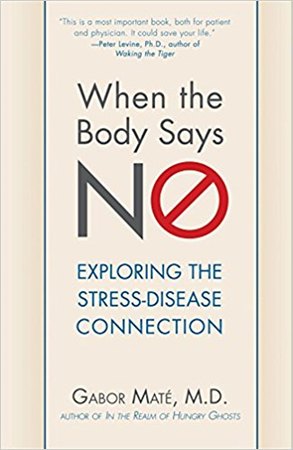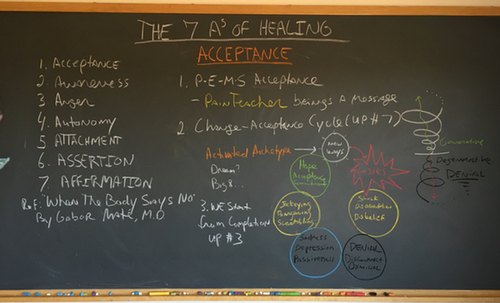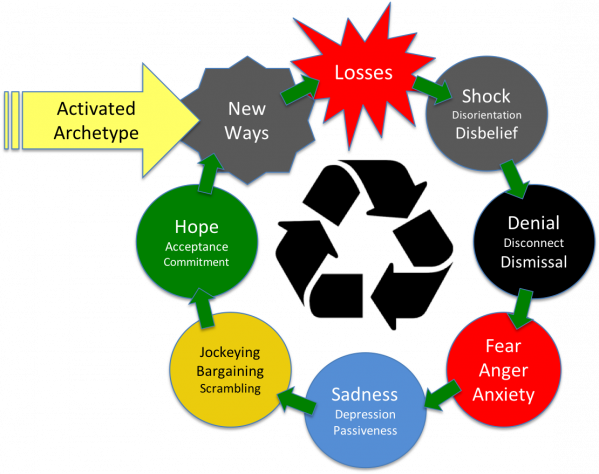The Seven A’s of Healing Part 1: Acceptance

Happy Monday to you all! I hope that life is wonderful wherever you live in the world.
Over the next few weeks, I’ll be sharing a new series of blogs/vlogs based on the final chapter of Dr. Gabor Mate’s excellent book, When The Body Says No: Exploring The Stress-Disease Connection, that outlines the Seven A’s of Healing. I’ve read many similar books, but this one’s up there with the very best.
Dr. Mate is a very skilled physician who interviewed something like 100 people with different diseases for his book and examined the psychological profiles of each of them very carefully.
In When The Body Says No, Dr. Mate shares a lot of cutting edge research in psychoneuroimmunology, which parallels very beautifully with current research in biopsychosocial medicine (it’s a subject I’ve spent a fair bit of time studying too).
Also, it’s very congruent with the teachings of C.H.E.K Institute, so that always makes me happy.
The Seven A’s of Healing are:
- Acceptance
- Awareness
- Anger
- Autonomy
- Attachment
- Assertion
- Affirmation
Because these words are very, very potent when it comes to healing, I have plenty to say in regard to how each of those Seven A’s of Healing should be understood and applied.
What does acceptance mean?
What does it mean to accept something? Because the antonym of acceptance is denial, your first tip of acceptance is that it means not to deny what is happening. When we’re in a state of acceptance, it often means we have the opportunity to look at a beautiful word called reality.
If we’re in denial, then we’re not in touch with reality. In order to really understand what’s happening, we also have to look at several of these other A’s, which we will do when we go into acceptance.
Typically, acceptance needs to be engaged at different levels. For one, we have to look at physical acceptance. For example, I’ve worked with young athletes with dreams of becoming professionals.
However, it’s very important for me to be honest with people and sometimes I have to say to them that the expectations they’re placing themselves are unrealistic based on the endeavors they’re pursuing.
Sometimes, we have to accept reality and not set ourselves up for repeated failures by getting in touch with what is more realistic. But if we accept and work with our limitations, this can create opportunities to redirect our energies in a different direction. For example, you may not be a successful basketball player, but you might be a better 10K runner.
How does that disconnect happen?
What we’re dealing with physically are the products of things we’re not effectively dealing with emotionally, mentally or spiritually. In other words, the physical end of our selves are usually what’s responding to the emotional, mental or spiritual for very simple reasons…
Matter is not self-animating. The atoms you’re made of will not eat your breakfast. They won’t make decisions for you. They’re organized by your thoughts, feelings and choices. It’s very, very rare that a physical challenge is the real problem, except in cases of devastating injuries or extreme trauma.
Often, emotions are moving through us and being denied or repressed. Where is fear your chief governing agency and how might that be an opportunity for growth?

Think about it…
Research shows that the average person thinks about 68,000 thoughts a day, of which 90 percent were found to be negative. So when we look at the fact that people spend most of their time using fear-based thinking to point themselves toward what they don’t want, it’s not hard to understand why we have so many people with chronic degenerative health conditions worldwide.
Often, along with that obsession toward the negative is a move away from the spiritual, a sense of being connected to something greater than you.
When we’re not connected to a greater whole, we tend to blame other people for our problems. We also can fall into isolation, which leads to a lot of anxiety and depression and feeling alone.
Then, our inner voice starts saying things like “nobody loves/cares about me. I’ll never have enough, and I’ll never be good enough.” That inner voice leads us down a degenerative spiral of our sense of self.
In many instances, acceptance is not only a physical, emotional or mental. Also, it requires that we take stock, which we’ll talk about in our next session on awareness, specifically where we are already connected, where we need to be connected for growth and healing and why we have been disconnected.
The Pain Teacher
Whenever we are facing a healing challenge, it’s evident that the Pain Teacher has arrived. Our culture is very quick to drug the Pain Teacher and not embrace the opportunity for awareness (we will discuss this next time).
Whenever the Pain Teacher shows up, it’s an invitation to awareness. I call it the Pain Teacher because it is the great awakener.
In previous blogs, I’ve cited Edward Edinger’s definition of consciousness: Consciousness is a psychic substance which is produced by the experience of opposites suffered, not blindly, but in living awareness.
When we’re not being conscious and living in awareness of opposites, we invite the Pain Teacher to enhance our vision and perception of reality, which is an invitation to step into our potential for growth, awareness and healing.
The Pain Teacher always brings a message, especially when we’re in a state of healing from any problem — a physical injury, divorce, job loss, death in the family or crisis — that disrupts our normal sense of flow, connection and wholeness along with our ability to fully engage ourselves, our relationships and dreams.

All of these are things that force us to deal with the issue of acceptance and where the Pain Teacher shows up.
When we’re situations like this and the Pain Teacher shows up, we either can go into a state of generative growth or a degenerative spiral, which is almost always linked with some form of denial of each of our own responsibilities in the process that we’re now engaged in.
You don’t want to get into denial because this makes our challenges much greater. It causes more repression. It leads to more of a likelihood that diseases will magnify and multiply. Cancer can become spread through the body. Anxiety can become depression and suicide.
My vlog discusses acceptance and the Pain Teacher in much greater detail along with Arnold Patent’s universal principles and the Big 8 archetypes and the Change Acceptance cycle, both of which I teach in my CHEK 4 Quadrant Coaching Mastery program.
I hope you enjoy watching my vlog and perfect the ways you think about the Seven A’s of Healing. Next time, I’ll discuss awareness and how that affects the myriad of ways you perceive and handle the world.
Love and chi,
Paul
Resources
How to Eat, Move and Be Healthy!
The Last 4 Doctors You’ll Ever Need
One Mind: How Our Individual Mind is Part of a Greater Consciousness and Why It Matters by Dr. Larry Dossey
Caroline Myss’ Four Archetypes of Survival
The works of Dr. Joe Dispenza, Dr. Daniel Siegel, Dr. Keith Witt and Drs. Harville Hendrix and Helen Hunt
